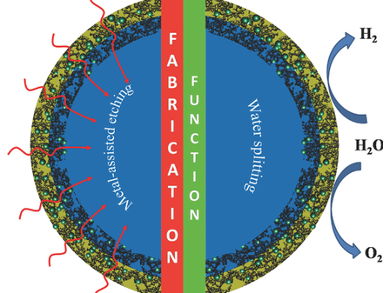The inherent high energy barriers associated with the two half reactions in water splitting, namely the hydrogen evolution reaction (HER) and the oxygen evolution reaction (OER), make catalysts unavaidable. But instead of using highly expensive Pt- and Ir-based catalysts, Yongqi Zhang, Nanyang Technologyical University, Singapore, and colleagues have combined two transition metal elements to form bimetal based catalysts.
For a HER catalyst polyvinylpyrrolidone (PVP), Ni and Mo metal salts were evenly covered on a carbon cloth by dip coating. The subsequent annealing under protecting Ar atmosphere converts the PVP and metal salts into N-doped carbon and metal-based nanoparticles. The same procedure was used for a OER catalyst, but with Ni and Fe metal salts along with PVP. The ultrafine size of the nanoparticles and the porous structure provide high density of active sites and a hybrid film structure avoids the aggregation of active material and improves the conductivity of the electrodes.
Analysis of the HER and OER showed full functionality as catalysts, as well as a good long-term stability. The overall water splitting properties of NiMo-PVP and NiFe-PVP electrodes were tested in 1 M KOH via two-electrode configuration. It shows a current density of 10 mA cm–2 at 1.66 V and, hence, the electrodes are promising substitutes for noble metal catalysts in high-efficient and low-cost water splitting, according to the researchers.
- Ultrafine Metal Nanoparticles/N-Doped Porous Carbon Hybrids Coated on Carbon Fibers as Flexible and Binder-Free Water Splitting Catalysts,
Yongqi Zhang, Xinhui Xia, Xun Cao, Bowei Zhang, Nguyen Huy Tiep, Haiyong He, Shi Chen, Yizhong Huang, Hong Jin Fan,
Adv. Energy Mater. 2017.
DOI: 10.1002/aenm.201700220



